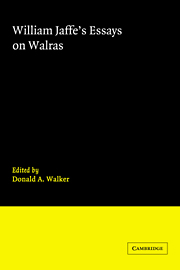Book contents
- Frontmatter
- Contents
- Preface
- Acknowledgments
- Introduction
- PART I WALRAS'S BIOGRAPHY
- PART II THE GENESIS AND DEVELOPMENT OF WALRAS'S IDEAS
- PART III THE SCOPE OF WALRAS'S WORK
- PART IV SPECIAL TOPICS IN WALRAS'S ECONOMICS
- PART V WALRAS'S PLACE IN THE HISTORY OF ECONOMIC THOUGHT
- 15 Reflections on the importance of Léon Walras (1971)
- 16 Léon Walras's role in the “marginal revolution” of the 1870s (1972)
- 17 Menger, Jevons and Walras de-homogenized (1976)
- 18 The normative bias of the Walrasian model: Walras versus Gossen (1977)
- 19 Walras's economics as others see it (1980)
- Index
19 - Walras's economics as others see it (1980)
Published online by Cambridge University Press: 05 May 2010
- Frontmatter
- Contents
- Preface
- Acknowledgments
- Introduction
- PART I WALRAS'S BIOGRAPHY
- PART II THE GENESIS AND DEVELOPMENT OF WALRAS'S IDEAS
- PART III THE SCOPE OF WALRAS'S WORK
- PART IV SPECIAL TOPICS IN WALRAS'S ECONOMICS
- PART V WALRAS'S PLACE IN THE HISTORY OF ECONOMIC THOUGHT
- 15 Reflections on the importance of Léon Walras (1971)
- 16 Léon Walras's role in the “marginal revolution” of the 1870s (1972)
- 17 Menger, Jevons and Walras de-homogenized (1976)
- 18 The normative bias of the Walrasian model: Walras versus Gossen (1977)
- 19 Walras's economics as others see it (1980)
- Index
Summary
Così è (se vi pare)
– Luigi PirandelloIn this article, as in my brief review of Michio Morishima's Walras' Economics: A Pure Theory of Capital and Money for the Economic Journal, the question is whether Morishima's interpretation of Walras's model is correct or whether his extensions, emendations, and corrections of the original model, designed to bring it in line with modern theoretical interests, distort the historical record. Let me say at once that Morishima's argument is by no means valueless for being flawed from the historian's point of view. On the contrary, such is the brilliance and analytical penetration of his misinterpretations that their very contrast with the original brings into sharp relief important but hitherto neglected aspects of Walras's theoretical writings.
At the outset of his preface to Walras' Economics (p. VII), Morishima expresses the hope that he “will not … give the reader a distorted view of Walras” by focusing attention exclusively on the Eléments (1874 …), without reference to Walras's other writings. A hope, however, is not a demonstration. The fact, which Morishima notes, that Léon Walras left his studies (Études) in applied and “social” economics in the form of two volumes of collected papers (1898; 1896) instead of systematically organized treatises is no proof of their irrelevance to an understanding of Walras's “theoretical kernel,” as Morishima calls it.
- Type
- Chapter
- Information
- William Jaffe's Essays on Walras , pp. 343 - 370Publisher: Cambridge University PressPrint publication year: 1983
- 7
- Cited by



